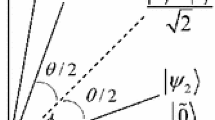Abstract
Recently, Su et al. (Opt Comm 283:4408–4410, 2010) proposed a quantum blind signature based on the two-state vector formalism. Their protocol is rather practical because the signer and the blind signature requester only have to perform measurement operations to complete the quantum blind signature. This study points out that a dishonest signer in their scheme can reveal the blind signature requester’s secret key and message without being detected by using Trojan horse attacks or the fake photon attack. A modified scheme is then proposed to avoid these attacks.
Similar content being viewed by others
References
Wen X., Niu X., Ji L., Tian Y.: A weak blind signature scheme based on quantum cryptography. Opt. Commun. 282(4), 666–669 (2009)
Wang, T.Y., Wen, Q.Y.: Fair quantum blind signatures. Chinese Phys B 19(6), (2010)
Su Q., Zheng H., Qiaoyan W., Wenmin L.: Quantum blind signature based on two-state vector formalism. Opt. Commun. 283(21), 4408–4410 (2010)
Cai Q.Y.: Eavesdropping on the two-way quantum communication protocols with invisible photons. Phys. Lett. A 351(1-2), 23–25 (2006)
Deng, F. G., Zhou, P., Li, X. H., Li, C. Y., Zhou, H. Y.: Robustness of two-way quantum communication protocols against trojan horse attack. Quant. Phy. (2005) arXiv:quant-ph/0508168v1
Li X.H., Deng F.G., Zhou H.Y.: Improving the security of secure direct communication based on the secret transmitting order of particles. Phys. Rev. A 74(5), 054302 (2006)
Deng F.G., Li X.H., Zhou H.Y., Zhang Z.J.: Improving the security of multiparty quantum secret sharing against Trojan horse attack (vol 72, art no 044302, 2005). Phys. Rev. A 73(4), 049901 (2006)
Deng F.G., Li X.H., Zhou H.Y., Zhang Z.J.: Improving the security of multiparty quantum secret sharing against Trojan horse attack. Phys. Rev. A 72(4), 044302 (2005)
Chong S.-K., Tsai C.-W., Hwang T.: Improvement on “quantum key agreement protocol with maximally entangled states”. Int. J. Throe. Phys. 50(6), 1793–1802 (2011)
Lin J., Tseng H.-Y., Hwang T.: Intercept–resend attacks on Chen et al.’s quantum private comparison protocol and the improvements. Opt. Commun. 284(9), 2412–2414 (2011)
Lin J., Hwang T.: An enhancement on Shi et al.’s multiparty quantum secret sharing protocol. Opt. Commun. 284(5), 1468–1471 (2011)
Author information
Authors and Affiliations
Corresponding author
Additional information
A comment to this article is available at http://dx.doi.org/10.1007/s11128-014-0744-8.
Rights and permissions
About this article
Cite this article
Yang, CW., Hwang, T. & Luo, YP. Enhancement on “quantum blind signature based on two-state vector formalism”. Quantum Inf Process 12, 109–117 (2013). https://doi.org/10.1007/s11128-012-0362-2
Received:
Accepted:
Published:
Issue Date:
DOI: https://doi.org/10.1007/s11128-012-0362-2



